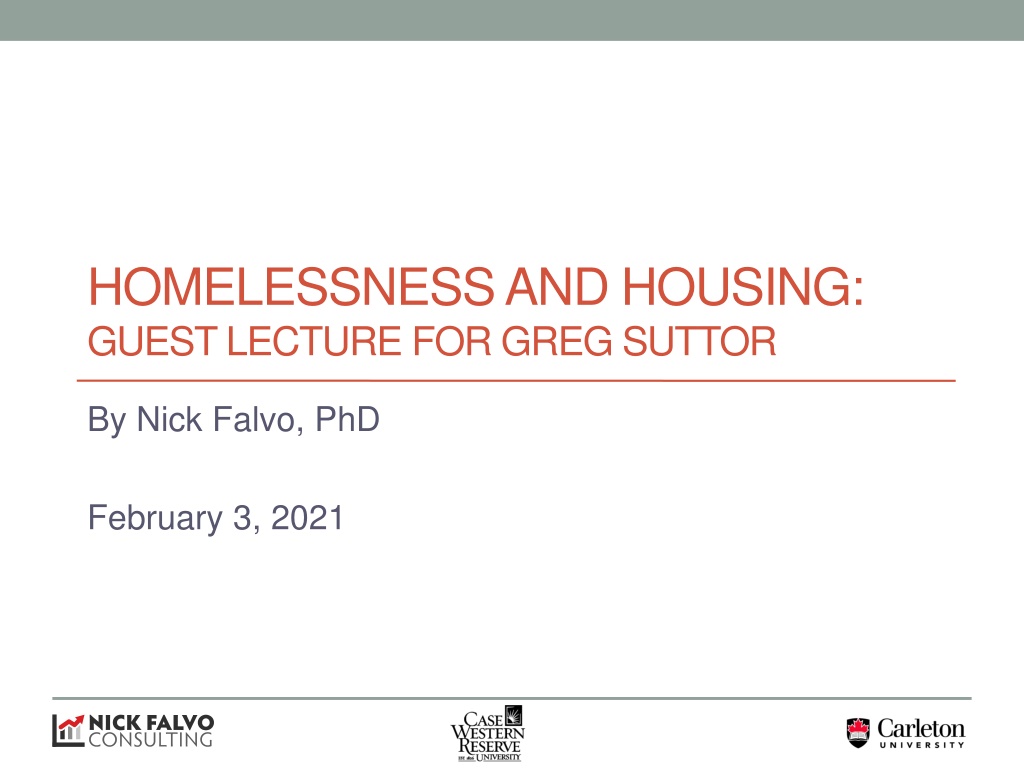
Guest Lecture on Homelessness and Housing Nexus
This guest lecture by Nick Falvo, PhD, explores the interconnectedness between homelessness and housing. It delves into the causes of homelessness, types of supportive housing, national housing strategies, and more. The presentation highlights structural, individual, and systemic factors contributing to homelessness, drawing on studies from the United States and Australia. The focus is on understanding how affordable housing and homelessness intersect in addressing this social issue.
Download Presentation

Please find below an Image/Link to download the presentation.
The content on the website is provided AS IS for your information and personal use only. It may not be sold, licensed, or shared on other websites without obtaining consent from the author. If you encounter any issues during the download, it is possible that the publisher has removed the file from their server.
You are allowed to download the files provided on this website for personal or commercial use, subject to the condition that they are used lawfully. All files are the property of their respective owners.
The content on the website is provided AS IS for your information and personal use only. It may not be sold, licensed, or shared on other websites without obtaining consent from the author.
E N D
Presentation Transcript
HOMELESSNESS AND HOUSING: GUEST LECTURE FOR GREG SUTTOR By Nick Falvo, PhD February 3, 2021
Overview What causes homelessness? Responses to homelessness What is supportive housing? What kind of supportive housing?
Overview (contd) National Housing Strategy Reaching Home Rapid Housing Initiative
Notes Today s presentation will attempt to focus on the nexus between homelessness and housing. In other words, it will focus on how the worlds of affordable housing and absolute homelessness connect. For referencing information, see the notes section at the bottom of each slide in the present deck (and if it s not there, email me: falvo.nicholas@gmail.com).
WHAT CAUSES HOMELESSNESS?
What causes homelessness? Three main categories of causes (also known as contributing factors, or predictors ). 1. Structural 2. Individual 3. Systemic
What causes homelessness? I recently reviewed four large studies looking at the structural causes. Three were done in the United States, one in Australia.
Giano et al. (2020) This is a review of the academic literature published about predictors of homelessness in the United States between 1970 and 2017.
Johnson et al. (2015) Australian study draws on a dataset with more than 100,000 homeless or at-risk individuals. They also surveyed approximately 1,700 people every six months for three years.
Hanratty (2017) + Byrne et al. (2013) Both are US studies using Point-in-Time Count data on approx. 400 communities.
What causes homelessness? Note that both Australia and the US are considered to be comparable to Canada. All three countries have relatively low levels of public social spending. The biggies from all 4 of these studies, in terms of structural causes, are: unemployment; poverty and median rent levels.
Responses to homelessness
Responses to homelessness In Canada, most influential thinkers agree that affordable housing is key to both preventing and responding to absolute homelessness. But there are important debates re: which precise people should be prioritized and how they should be prioritized. There are also debates re: what the affordable housing should look like (e.g., scattered site vs. place-based).
Responses to homelessness (contd) And there are certainly debates re: who should pay for which components of that affordable housing. Finally, there are fundamental debates re: how much each order of govt should be investing in social policy in general.
Responses to homelessness (contd) And there are now emerging debates re: how much emphasis should be placed on preventing absolute homelessness vs. responding to absolute homelessness.
Responses to homelessness (contd) Key question: how many resources do you put into the various policy responses? Some clients will always need social work support, once housed. Some will not. Some system-planning organizations are trying to do more with less. Experimentation e.g., Adaptive Case Management.
Responses to homelessness (contd) There are also debates as to the intensity of the staff support, once a person receives affordable housing.
Responses to homelessness (contd) The Calgary Drop-In uses a tool called the Needs and Services Questionnaire (NSQ), carried out with staff who have strong knowledge of a client. This tool guides staff to three types of policy responses: 1) Place-based Supportive Housing (PSH); 2) housing with intensive supports (scattered site); and 3) rapid rehousing.
Supportive housing Prior to the 1980s, persons experiencing absolute homelessness were not a major focus of affordable housing policy. However, as absolute homelessness began to emerge as a pressing public policy challenge, this changed (at least in Ontario).
Supportive housing (contd) In the 1980s, a public policy response soon emerged that focused on re-housing persons with social work support that is, providing them with subsidized housing along with social work support. This became known as supportive housing (today, the term Housing First means almost the same thing). Most residents of supportive housing have been single adults without dependants.
Supportive housing (contd) The type of social work support provided is the subject of much debate, especially at the local level. When I provided such support while working in Toronto, I provided a lot of assistance with appointments (e.g., with family physicians, income support workers, court appointments). I often took my clients for coffee.
Supportive housing (contd) I helped advocate for my clients if they were brought to the rental housing tribunal. I helped several clients relocate into new units. I once visited one of my clients in rehab (out of town). I once helped a client with bed bugs by prepping the unit for treatment.
Supportive housing (contd) With place-based supportive housing, it s relatively easy (logistically) to organize group social activities (e.g., physical exercise, art). Place-based supportive housing also offers important assistance with guest management. Place-based supportive housing also makes it relatively easy to have an on-site meal program.
Supportive housing (contd) Some supportive housing providers encourage community development activities. When I was on the Board of Directors at Houselink Community Homes (about 20 yrs. ago) half of our board members were Houselink tenants. We also made sure that, at any one time, either the board president or vice- president was a Houselink tenant.
Supportive housing (contd) Also at that time, Houselink had a drop-in program offered at one of their buildings. Tenants could just sit and chill together (typically with some food and coffee provided).
Supportive housing (contd) Last year, Houselink and Mainstay wanted to merge and become one larger organization. But this was subject to a binding referendum in which tenants voted. According to each organization s by-laws, had the tenants voted not to merge, the two organizations would not have been able to.
Supportive housing (contd) In the early-1980s (and possibly before) City of Toronto officials were concerned about the fact that a large # of persons in their emergency shelters were in fact using them for much more than emergency shelters. They were staying there indefinitely, and they needed more than just a roof over their heads. They needed some sort of social work support.
Supportive housing (contd) In part due to this phenomenon, Ontario s provincial government began to fund supportive housing for persons with serious mental health challenges. Some non-profits became particularly innovative in this respect. Homes First Society (in Toronto) was particularly innovative.
Supportive housing (contd) In 1984, Homes First Society opened its 90 Shuter Street complex, which was Toronto s very first government- assisted housing dedicated to homeless single people Similar policy developments were taking place in Ottawa, for the same reasons.
Supportive housing (contd) But this didn t all happen in a political vacuum. Advocacy had a major impact on it. In Toronto, this included the Singles Displaced Persons Project, the consumer survivor movement, the slogan homes not hostels and the founding of organizations such as Houselink and Homes First Society.
Supportive housing (contd) In Canada, the Housing First narrative became popular in the early 2000s. City of Toronto (Iain De Jong in particular) pushed this hard and effectively as it rolled out Streets to Homes. The narrative had been made popular in the US by Sam Tsemberis. Calgary Homeless Foundation picked it up quickly as well.
Supportive housing (contd) The Housing First narrative placed (and still places) great emphasis on the importance of not requiring housing readiness as a condition of housing receipt. But many supportive housing providers in Ontario already did not require housing readiness. Homes First Society, Houselink and Mainstay (all based in Toronto) did not require housing readiness per se.
Supportive housing (contd) Ideologically, Housing First wasn t exactly left or right. It was third way political advocacy and still is. And largely because of that third way approach, it s found traction among business leaders as well as many more grassroots advocates.
Supportive housing (contd) Because Housing First talked about providing housing with few if any strings attached (re: behaviour) it gained traction among some advocates on the left. And because it put great emphasis on the need to re- allocate existing resources, it gained traction among many on the right (and business leaders).
Supportive housing (contd) This was further advanced by the At Home/Chez Soi study (a 5-city randomized controlled study). Participants with moderate needs received Intensive Case Management (ICM), while those with higher levels of need received Assertive Community Treatment (ACT). Participants were interviewed every 3 months over 2 yrs. Demonstrated successful outcomes and cost savings.
Supportive housing (contd) Note: 16% of the study participants who received Housing First (i.e., help finding an apt., $ to pay for the apt., & health and social-work support) weren t able to hang on to an apartment for any significant length of time (in fact, some of them remained homeless the entire time). Most researchers, advocates and practitioners have been quite silent on this finding s implications.
Supportive housing (contd) Supportive housing/Housing First remains very popular as a policy response. For example, the Calgary Homeless Foundation (CHF) is one of North America s most well-respected homelessness non-profits. More than of operating dollars disbursed by CHF to local non-profits annually are on supportive housing (though they tend to use the term Housing First).
Supportive housing (contd) Canada s National Housing Strategy, unveiled in 2017, contains no specific provisions for supportive housing. Yet, the September 2020 Federal Throne Speech includes a commitment to completely eliminate chronic homelessness.
Supportive housing (contd) Debates remain on the following question: Should a non-profit/public entity own the building, or should a for-profit entity own the building? Should the landlord and support functions be separated (i.e., delivered by different entities)?
Supportive housing (contd) What % of units in a building should be supportive housing units? Should it be 100% or a much smaller percentage? For how long should social work support be provided? Should it be provided for just a few months or indefinitely?
Supportive housing (contd) Who exactly should be prioritized for new available units and what should the prioritization process look like? Which order of government should pay for what aspect of new supportive housing units?
Supportive housing (contd) There are in fact many types of supportive housing. For ex: the frail elderly, youth (including for LGBTQ2S+ youth specifically), Indigenous ppls, and veterans; also, for persons w substance use challenges, developmental disabilities and HIV/AIDS. Yet, most public policy attention on supportive housing pertains to persons w mental health challenges.
What kind of supportive housing?
Who should own the building? Many people think it s important for a public or non-profit entity to own and operate housing, including housing for persons who have experienced long-term homelessness. They argue that there are long-term cost benefits to owning the asset (especially the land). Regrettably, there is very little research re: long-term cost benefits of owning supportive housing.
What should tenant demographic look like throughout the building? Some ppl believe very strongly in scattered site housing (e.g., no more than 15% of units of one building being designated for a specific tenant demographic). Others believe that very high need tenants require 24-hr support (i.e., single-site, or place-based supportive housing).






















